The Maryland Monument
Introduction
Text-to-speech Audio
Images
The Maryland Monument
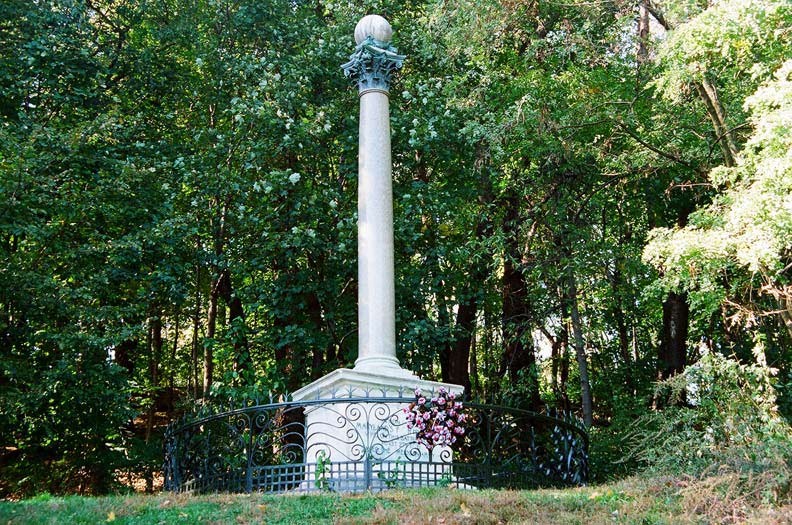
Inscription on one side of the pedestal
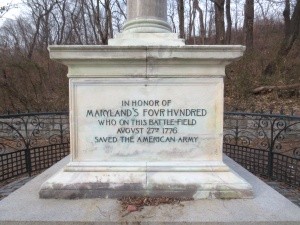
Inscription on another side of the pedestal
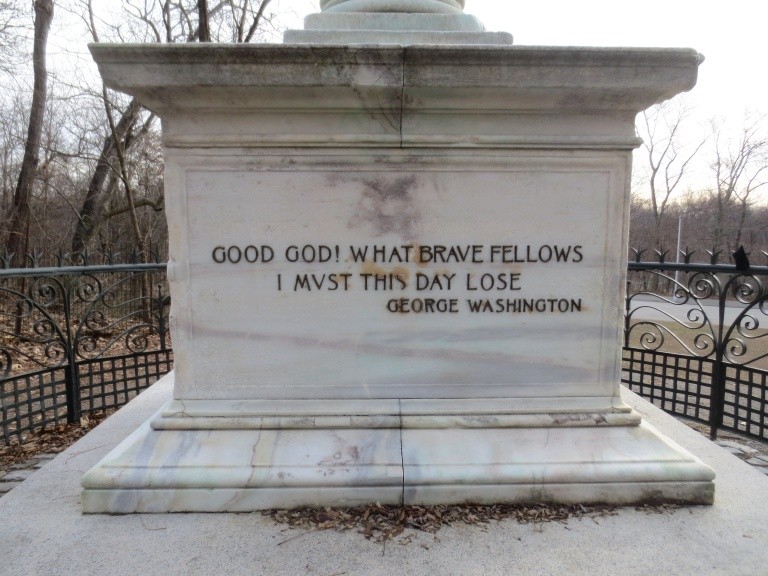
"The Battle of Long Island" by Alonzo Chappel (1858) depicts the stand of the "Maryland 400"
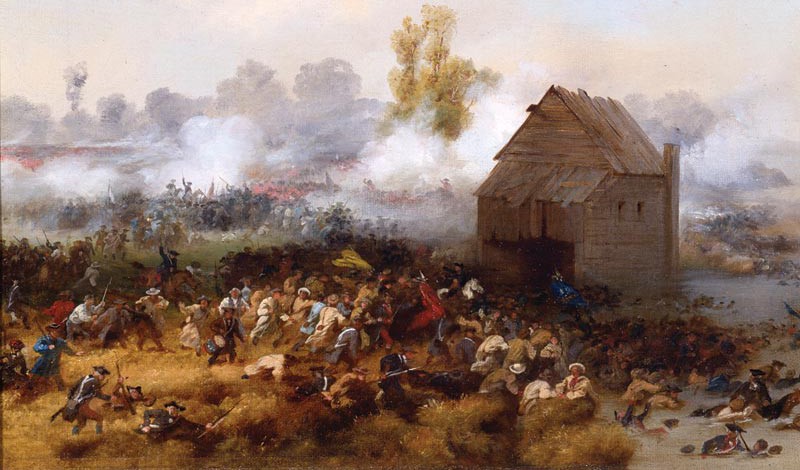
"Retreat at Long Island," an engraving by J.C. Armytage
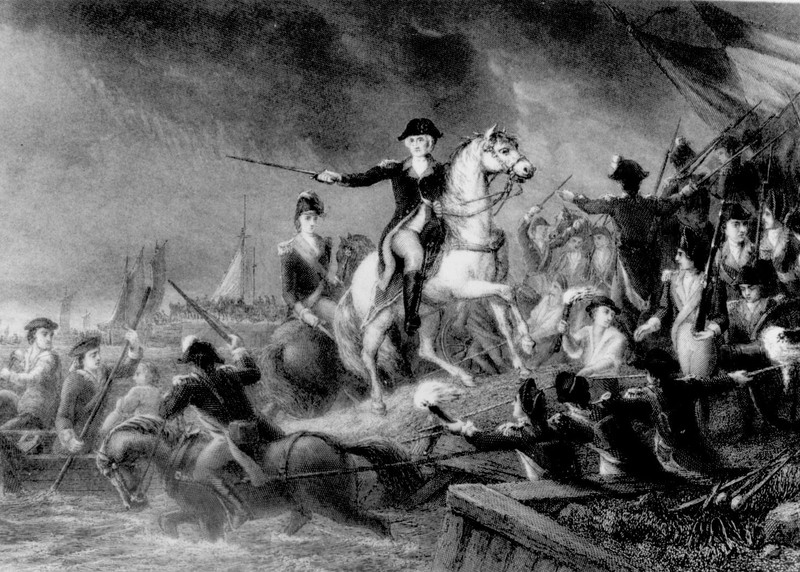
Backstory and Context
Text-to-speech Audio
In mid-March 1776, under pressure from the fortified and heavily-armed American position on Dorchester Heights overlooking the city, British forces under the command of General William Howe evacuated Boston. Anticipating his opponent’s next move, General George Washington moved the Continental Army to New York in April and May and began preparing for the city’s defense. With so much territory to cover, he divided his army, keeping roughly two-thirds of his men with him in Manhattan and ordering the remaining third to Brooklyn to cover his left flank. The decision proved to be a terrible mistake.
In late June, Howe arrived with hundreds of ships carrying an army of about 30,000 men. Throughout July and early August, he established his headquarters on Staten Island and plotted his move against Washington. On August 22, Howe’s army landed on the southern beaches of Brooklyn. At Brooklyn, the Americans held two positions: Guan Heights to the south and Brooklyn Heights to the north. On August 27, a contingent of British regulars under the command of General James Grant and Hessian mercenaries under the command of General Leopold Philip Von Heister attacked the American forces at Guan Heights from the south, while Howe, with 10,000 men, flanked them from the east. The outnumbered Americans were quickly overwhelmed. As their brothers in arms retreated north to Brooklyn Heights, a Maryland unit of about 400 men under the command of Lord Stirling provided covering fire and counter-charged the advancing enemy forces. The Maryland contingent accomplished its mission, but at a high cost, losing more than 250 men. The remains of the Maryland soldiers were buried on a plot of land on what is now Third Avenue between Eighth and Ninth Streets.
By nightfall, American forces were trapped on Brooklyn Heights. Howe’s army threatened from the south and east and British ships patrolled the East River. Rather than continuing to press the American forces, Howe decided to dig in and lay siege to their position. A few days later, a storm drove British ships down river, allowing for American forces to retreat across the East River under the cover of darkness. While the British were victorious at the Battle of Long Island (also known as the Battle of Brooklyn), Washington managed to escape with his army intact and the story of the bravery and sacrifice of the Maryland men gave the cause of independence a much-needed morale boost when it so desperately needed it.
Over one hundred years later, the Maryland Society of the Sons of the American Revolution donated a monument to commemorate the bravery and sacrifice of the “Maryland 400” during the Battle of Long Island. Designed by architect Stanford White, the monument is composed of a twelve-foot-tall granite column topped with a bronze Corinthian capital and a marble sphere. The shaft sits on a marble pedestal donated by the Brooklyn Parks Department. On August 27, 1895, the 119th anniversary of the engagement, the monument was unveiled during an elaborate ceremony at the foot of Lookout Hill in Brooklyn’s Prospect Park, near where the Marylanders made their stand. In attendance were members of the Grand Army of the Republic, the Fourteenth Regiment of the New York State National Guard, and various historical societies. They were joined by special guests, the lieutenant governor of New York and the mayors of New York City and Brooklyn.
Since its dedication in 1895, the Maryland Monument has undergone several restoration efforts. In the mid-1930s, the Works Progress Administration sponsored the first restoration of the Prospect Park monument. A little over thirty years later, in 1969, a second restoration effort occurred. In 1991, thanks to support from the Governor’s Commission on Maryland Military Monuments, the monument's granite and marble pieces were repointed, its surfaces cleaned, and its perimeter fence mended. Most recently, in 2008, the Citywide Monuments Conservation Program partnered with the Maryland Historic Trust to replace the missing bronze letters from the monument’s marble pedestal.
Sources
"Battle of Long Island." Encyclopaedia Britannica. Web. 16 October 2020 <https://www.britannica.com/event/Battle-of-Long-Island>.
"Battle of Long Island." The Digital Encyclopedia of George Washington. Mount Vernon Ladies' Association. Web. 16 October 2020 <https://www.mountvernon.org/library/digitalhistory/digital-encyclopedia/article/battle-of-long-island/>.
"Brooklyn Long Island." American Battlefield Trust. Web. 16 October 2020 <https://www.battlefields.org/learn/revolutionary-war/battles/brooklyn>.
"Maryland Monument." New York City Department of Parks and Recreation. The City of New York. Web. 16 October 2020 <https://www.nycgovparks.org/parks/B073/highlights/19641>.
https://forgotten-ny.com/2014/02/the-maryland-monument-prospect-park/
https://diannedurantewriter.com/archives/2878
https://diannedurantewriter.com/archives/2878
https://msamaryland400.wordpress.com
https://www.britannica.com/event/Battle-of-Long-Island
